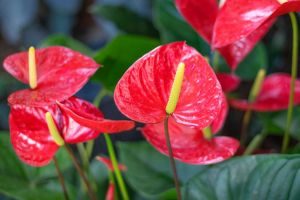Anthurium flowers are among the most stunning and elegant flowers in the world. Their unique shape and vibrant colors make them popular not only for decoration but also for gifts and weddings. Here is everything you need to know about Anthurium flowers, from their history and characteristics to their care and maintenance.
History and Characteristics of the Anthurium
Anthurium flowers are native to tropical regions of South and Central America. They are also found in parts of the Caribbean. They were first discovered in the 1800s by European botanists who were fascinated by their unusual shape and bright colors. The name “Anthurium” comes from the Greek words “anthos” (flower) and “oura” (tail), referring to the plant’s distinctive, tail-like spadix.
The most striking feature of Anthurium flowers is their heart-shaped, glossy leaves that can range from dark green to almost black. They grow on long stems that can reach up to 18 inches in height, and their inflorescence (the part of the plant that bears flowers) consists of a brightly colored, waxy spathe that can take on a variety of shades, including red, pink, orange, purple, white, and green. The spadix that emerges from the center of the spathe is typically yellow, green, or white, and contains numerous tiny flowers.

Care and Maintenance
If you’re thinking about adding Anthurium flowers to your indoor or outdoor garden, you’ll be happy to know that they are relatively easy to care for. Here are a few tips to keep in mind:
Light
Anthurium flowers prefer bright, indirect light, so be sure to place them near a window or in a well-lit room. However, direct sunlight can burn their leaves, so avoid placing them in direct sunlight.
Water
They need to be watered regularly, but not too much. Allow the top inch of soil to dry out between waterings, and avoid letting the soil become waterlogged.
Humidity
Anthurium flowers thrive in high humidity, so consider using a humidifier or placing a tray of water near the plant to increase humidity levels.
Fertilizer
Fertilize every two to four weeks during the growing season (spring and summer) with a balanced fertilizer.
Repotting
Re-pot every two to three years to provide fresh soil and more room for growth.
Benefits of Anthurium Flowers
Anthurium flowers are not only beautiful, but they also have a number of health benefits. The plant’s leaves and stems contain calcium oxalate crystals, which can irritate the skin and mucous membranes if ingested. However, these same crystals have been found to have antimicrobial properties and may help protect against certain types of bacteria and viruses. In addition, Anthurium flowers have been shown to have air-purifying properties and can help remove toxins from the air, making them a great choice for indoor spaces.
Anthurium flowers are a stunning and easy-to-care-for addition to any indoor or outdoor garden. With their heart-shaped leaves and brightly colored spathes, they are sure to add a pop of color and elegance to your space. By following these simple care and maintenance tips, you can enjoy their beauty for years to come.